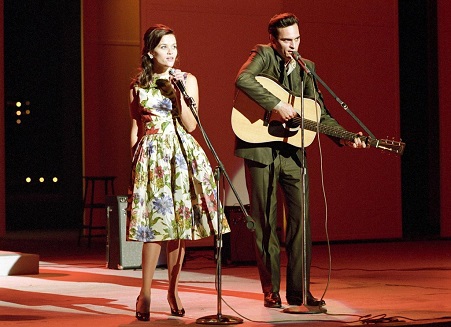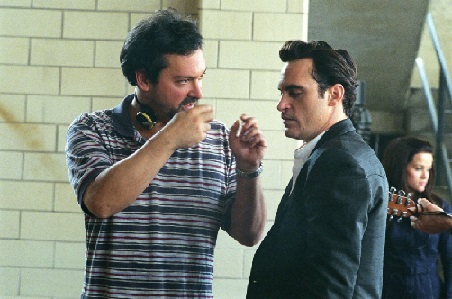Biopic movies have had a place in cinema since I began taking movies serious enough to rank movies. Country musician Johnny Cash received such treatment based in part on his autobiographies Man in Black: His Own Story in His Own Words of 1975 and Cash: The Autobiography, with Patrick Carr, of 1997 plus. Walk the Line (2005) received that plus deeper treatment with additional screenwriting from Gill Dennis and director James Mangold. Friend of the Matt Lynn Digital blog Cobra listed Walk the Line at #16 on his listing of top 20 movies as recently as 2018.

The movie itself begins with scenes of family life for the Johnny Cash from 1944 in Dyess, Arkansas. We meet Johnny Cash‘s mother Carrie, his abusive father Ray, and his brother Jack. Robert Patrick, Shelby Lynne, Lucas Till and Ridge Canipe portrayed Ray, Carrie, Jack and Johnny at this point of the movie, with tragedy befalling Jack and Ray severely resenting Johnny for it. Joaquin Phoenix would go on to portray Johnny Cash as an adult.

It’s 1950 when Johnny Cash joins the U.S. Air Force. Cash takes a liking to writing songs while stationed in West Germany, developing Folsom Prison Blues before returning to the United States when discharged in 1954. Cash would marry his first wife, Vivian Cash as portrayed by Ginnifer Goodwin, before the couple moved to Memphis, Tennessee. Vivian inspired Cash‘s first hit song I Walk the Line.

The absence of success as a door-to-door salesman as a means of supporting his family, in part, led Cash to seek an audition with a small band for Sam Phillips, the owner of Sun Records. While Cash, Luther Perkins and Marshall Grant first aimed to play gospel music, it was Folsom Prison Blues that won the trio a contract and financial success. Among others, the three would begin touring with Jerry Lee Lewis, Elvis Presley and Carl Perkins, as portrayed respectively by Waylon Payne, Tyler Hilton and John Holiday. Dallas Roberts portrayed Sam Phillips.

The touring introduces Johnny Cash to June Carter, as portrayed by Reese Witherspoon. The influence Carter has on Johnny Cash is a source of friction for Vivian Cash. Feelings of love develop between the pair, though attempts from Johnny to initiate a romantic relationship with June are initially rebuffed. A large portion of the film is dedicated to this dynamic, the children between the separate marriages for the pair, and the familial drama that remains between Ray and Johnny Cash. The eventual intimacy, drug and alcohol overuse by Johnny, an eventful Thanksgiving on that path, and a dynamic journey to ultimately get there provides depth to the personal story that is told by Walk the Line.

Walk the Line is well crafted entertainment with a strong underlying narrative. The drama is true to the music style of June Carter and Johnny Cash, with feelings of love and social norms of the larger society factoring into the tale. Learning more about the music and the biography of the early part of Cash’s family and career was worthy of my time, too. I rate Walk the Line as directed by James Mangold at 4.0-stars on a scale of one-to-five.
Matt – Wednesday, September 20, 2023













 (This is the album cover for the Violator album by Depeche Mode).
(This is the album cover for the Violator album by Depeche Mode). (From left are Depeche Mode members Martin Gore, Dave Gahan, Alan Wilder, and Andrew Fletcher).
(From left are Depeche Mode members Martin Gore, Dave Gahan, Alan Wilder, and Andrew Fletcher).
 (The album Here’s Little Richard was published with Little Richard getting top billing on his initial album release).
(The album Here’s Little Richard was published with Little Richard getting top billing on his initial album release). (Richard Penniman, aka Little Richard was a pioneer for rock & roll, with loud singing, distinctive beats, and a model that made for a distinctive sound. This pioneering panache landed Little Richard in the Rock & Roll Hall of Fame in 1986).
(Richard Penniman, aka Little Richard was a pioneer for rock & roll, with loud singing, distinctive beats, and a model that made for a distinctive sound. This pioneering panache landed Little Richard in the Rock & Roll Hall of Fame in 1986). (Slippin’ and Slidin’ was a single released by Little Richard prior to the album Here’s Little Richard. The B-Side of the single was Long Tall Sally).
(Slippin’ and Slidin’ was a single released by Little Richard prior to the album Here’s Little Richard. The B-Side of the single was Long Tall Sally). (Rip It Up was a single released by Little Richard with Ready Teddy as the B-Side before the album Here’s Little Richard landed in March, 1957).
(Rip It Up was a single released by Little Richard with Ready Teddy as the B-Side before the album Here’s Little Richard landed in March, 1957).